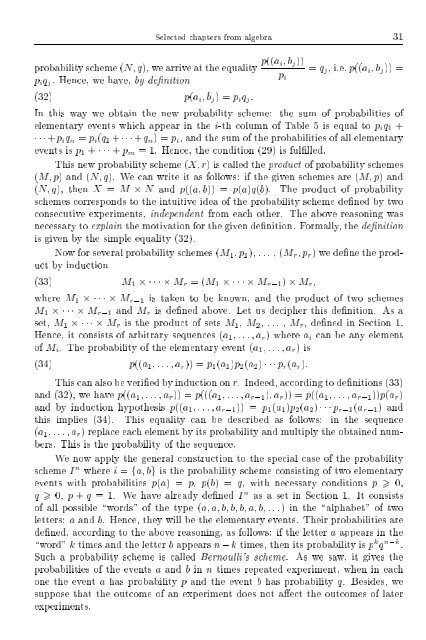SELECTED CHAPTERS FROM ALGEBRA I. R. Shafarevich Preface
SELECTED CHAPTERS FROM ALGEBRA I. R. Shafarevich Preface
SELECTED CHAPTERS FROM ALGEBRA I. R. Shafarevich Preface
Create successful ePaper yourself
Turn your PDF publications into a flip-book with our unique Google optimized e-Paper software.
Selected chapters from algebra 31probabilityscheme (Nq), wearrive at the equality p((a ib j ))p i= q j , i.e. p((a i b j )) =p i q j . Hence, we have, by denition(32) p(a i b j )=p i q j :In this way we obtain the new probability scheme: the sum of probabilities ofelementary events which appear in the i-th column of Table 5 is equal to p i q 1 ++p i q n = p i (q 1 ++q n )=p i , and the sum of the probabilities of all elementaryevents is p 1 + + p m =1. Hence, the condition (29) is fullled.This new probability scheme (X r) is called the product of probability schemes(Mp) and(Nq). We can write it as follows: if the given schemes are (Mp) and(Nq), then X = M N and p((a b)) = p(a)q(b). The product of probabilityschemes corresponds to the intuitive idea of the probability scheme dened by twoconsecutive experiments, independent from each other. The above reasoning wasnecessary to explain the motivation for the given denition. Formally, thedenitionis given by the simple equality (32).Now for several probabilityschemes (M 1 p 1 ), . . . , (M r p r )we dene the productby induction(33) M 1 M r =(M 1 M r;1 ) M r where M 1 M r;1 is taken to be known, and the product of two schemesM 1 M r;1 and M r is dened above. Let us decipher this denition. As aset, M 1 M r is the product of sets M 1 , M 2 ,...,M r , dened in Section 1.Hence, it consists of arbitrary sequences (a 1 ...a r )wherea i can be any elementof M i . The probability of the elementary event (a 1 ...a r )is(34) p((a 1 ...a r )) = p 1 (a 1 )p 2 (a 2 )p r (a r ):This can also be veried by induction on r. Indeed, according to denitions (33)and (32), we have p((a 1 ...a r )) = p(((a 1 ...a r;1 )a r )) = p((a 1 ...a r;1 ))p(a r )and by induction hypothesis p((a 1 ...a r;1 )) = p 1 (a 1 )p 2 (a 2 )p r;1 (a r;1 ) andthis implies (34). This equality can be described as follows: in the sequence(a 1 ...a r ) replace each element by its probability and multiply the obtained numbers.This is the probability of the sequence.We now apply the general construction to the special case of the probabilityscheme I n where i = fa bg is the probability scheme consisting of two elementaryevents with probabilities p(a) = p, p(b) = q, with necessary conditions p > 0,q > 0, p + q = 1. We have already dened I n as a set in Section 1. It consistsof all possible \words" of the type (a a b b b a b ...) in the \alphabet" of twoletters: a and b. Hence, they will be the elementary events. Their probabilities aredened, according to the above reasoning, as follows: if the letter a appears in the\word" k times and the letter b appears n;k times, then its probability isp k q n;k .Such a probability scheme is called Bernoulli's scheme. As we saw, it gives theprobabilities of the events a and b in n times repeated experiment, when in eachone the event a has probability p and the event b has probability q. Besides, wesuppose that the outcome of an experiment doesnotaectthe outcomes of laterexperiments.
















